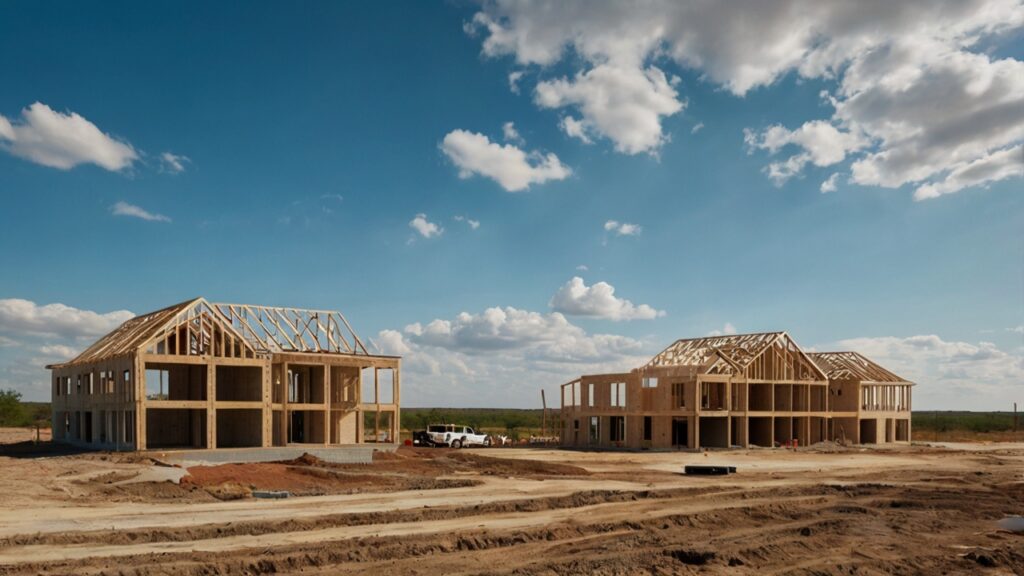
Constructing a home with nothing but your vision in mind is the desire of many, especially in states such as Texas where there is enough land for miles around and the landscapes are dotted with vibrant communities, the idea is even more appealing. But few inquiries are more common than: How long does it take to build a house from scratch?
There’s no one answer, but 7-12 months is a typical time frame, and a lot will depend on variables like location, design complexity, permits, weather and how organized the builder is. This is by focusing on each phase of the construction timeline, giving you a sense of what to expect, and an action plan for what to do next, so you can get started building your dream home.
1. Pre-Construction Phase (1–3 Months)
Before a single wall can get built, there are several other key steps that must be undertaken:
- Financing & Budgeting: Securing a loan, such as a VA Construction Loan, is the first step for many homebuyers. These loans are excellent for veterans and military families looking to build with low or no down payment.
- Design & Planning: This includes selecting a floor plan, working with architects, and submitting plans to local authorities.
- Permits & Approvals: Permitting timelines vary by municipality but can take weeks or even a couple of months in some areas.
- Land Acquisition: You must own a buildable lot. If you’re still looking for the right location, check out this guide on where to buy land in Texas.
2. Site Preparation and Foundation (2–4 Weeks)
Once the land is cleared and leveled, the next step is to pour the foundation. Depending on your home’s design, this could be a slab, crawl space, or full basement. Factors such as soil quality, weather, and engineering requirements will influence the timeline. Delays often happen here if unexpected site conditions (like rocky soil) are discovered.
3. Framing and Structural Work (1–2 Months)
This is when the house begins to coalesce. The framing includes:
- Walls
- Roof trusses
- Windows and doors (rough openings)
This stage, you can walk through and see the arrangement. Remember that this stage can be slowed down a lot by weather, particularly substantial rain or winds.
4. Mechanical, Electrical & Plumbing (1–2 Months)
Known as MEP Services, it consist of:
- Electrical wiring
- Plumbing lines
- HVAC ductwork
When finished, the installations will be inspected by the local building inspector to verify compliance with code. Scheduling the inspections may cause minor delays but they’re an important part of the process.
5. Insulation, Drywall & Interior Finishes (1–2 Months)
Insulation is next, then drywall after the house passes inspections. Next is painting, flooring, cabinetry, countertops and tiling. This is when your house begins to take on more of a lived-in look.
This stage can be extended by any custom features or special material orders (such as exotic tiles or hardwood). Effective communication with your builder is crucial in ensuring everything remains as it should.
6. Exterior Work (2–4 Weeks)
Even as interior work continues, progress is also made on the exterior:
- Siding
- Roofing
- Painting
- Landscaping
These are weather-dependent projects, so delays are possible if there’s unanticipated rain or supply chain issues.
7. Final Touches and Inspections (2–4 Weeks)
Before you can even move into the home, final walk-through and inspection must be conducted. This includes:
- Fixing minor issues (often called a “punch list”)
- Ensuring all utilities are connected
- Receiving a Certificate of Occupancy (CO)
Factors That Can Extend or Shorten the Timeline
Our proposal can usually range from 7 – 12 months, but there are some factors that we may adjust our schedule to meet your needs:
- Supply of materials: Global supply chain problems could slow the shipment of important items, like windows or appliances.
- Builder experience: When you hire top Texas home builders you can trust that your construction project is in good hands.
- Level of customization: More customized homes typically take longer due to specialized labor and material.
- Approvals: Some cities and counties move more quickly than others to sign off on permits.
- Weather: Texas weather is unpredictable and little is certain smooth sailing; heavy rain or extreme temperatures could cause delays.
How to Stay on Schedule
It takes planning and teamwork to stay on schedule. Here are a few tips to help:
- Select the best builder: A great builder with strong communication skills can be the difference between making and missing the timeline.
- Be firm: Changes during construction may set you back by weeks or even months.
- Know your loan process: If you are working with one of the top Texas construction loan builders, they can walk you through financing, inspections, and a timeline.
- Frequent check-ins: You do not want to come to the end of the project, only to find out you needed to make changes early on. Communicate with your project manager to ensure your project is on the right track.
Final Thoughts
So, how long does it take to build a house from the ground up? While 7 to 12 months is the average, many factors influence this timeline. By choosing the right location, securing smart financing options, and working with experienced builders, you can streamline the process and enjoy a home built exactly to your specifications.
Ready to start your journey? Whether you are a seasoned home-buyer looking into a VA loan, or just need expert guidance on finding the perfect land and builder, we are here to help you every step of the way.
